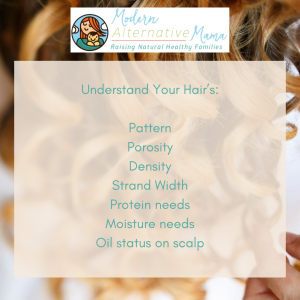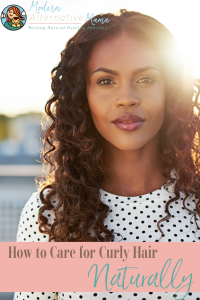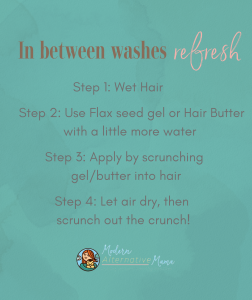By Rustina, Contributing Writer
I used to dream of having perfect soft and bouncy curls (without the hours of curling and tons of hair spray). I had straight hair, like dried spaghetti noodle straight, as a teenager. At some point in my 20s though, it started changing to wavy hair. Now, I have curly hair with some of the ringlets I used to dream of having! While it isn’t quite the Shirley Temple look, I love caring and nurturing the curls that I do have!
The best part is that I do it using natural hair care products. No questionable ingredients, no health-damaging side effects to worry about, or products that cause hair loss and court litigations. Just clean, simple, nourishing hair care.
Your hair can tell you what it needs, and you can get your best and most natural, bouncy curls without expensive, toxic products!
Understanding Your Hair’s Needs
All hair is different and has different needs – some will need cool water, hot water, more oil, less oil, some need more consumed nutrients, some need help balancing the gut so nutrients can be utilized, and some need more pH balancing washes. Knowing what your hair needs will depend on the following important hair details to get started:
Your Hair’s…
- Pattern
- Porosity
- Density
- Strand Width
- Protein needs
- Moisture needs
- Oil status on scalp
What do those details mean for your hair?
Knowing each of these details can direct you towards natural ingredients that work well for your hair style and routine.
Pattern
Curly hair patterns are wavy (S shaped or loose zigzags), curly (loose ringlets), coily (tight ringlets), and kinky (tight zigzags). Curly, Coily, and Kinky hair often needs a touch more oil to keep the frizz down and the hair moisturized. The type of oil used to condition your hair will depend on the other details as well.
Porosity
Porosity is about how much moisture the cuticle can obtain and keep locked in. If hair is low porosity, then the outer shell’s scales are closed tightly, not letting moisture in or out easily. That also means it does not absorb oils easily either so the natural oils build up on the scalp, causing irritation; or they start rolling down the strands, making hair look greasy.
This needs weekly or biweekly clarifying washes. Just mix 1 cup of water, ½ cup of vinegar, and if wanted, a few drops of essential oils to massage into the scalp for a nice, refreshingly clean scalp. This removes all that extra product and oil build up.
Reducing the amount of product by using simple and natural ingredients will, over time, make the scalp much healthier. A little bit of heated oil on wet strands (not scalp) will help the hair pull in as much as possible while providing a nice shine.
If hair is high porosity, then the scales are raised and open – like a heated up pinecone – letting moisture and oils in, but letting the moisture out just as quickly, leaving your hair dry and weak. This needs a gentle wash with lots of nourishing oils and humectants to lock in and continue to bring in more moisture to the hair strand.
Want to learn how to tell exactly what type of porosity you have and which oils to use? Check out that and simple DIY recipes in the free Hair Care Guide!
Density
Density is how many hair strands you have coming out of the scalp. If you look at your part line, you can get a really good idea of the density.
If you see barely any scalp along the part line, then you have high density.
If you see the part line well and beyond the part line pretty well, then you have low density.
Higher density tends to need more conditioning oils and hair butters to keep the puffiness down. Low density can be helped by using lightweight leave-in conditioners and avoiding heavy oils and butters that may weigh the hair down.
Hair Strand Width
Knowing your hair strand width helps in a similar fashion as density. If you have fine hair, then you want to avoid weighing it down with heavy oils and butters. If you have more coarse hair, then you may need more oils and butters to keep it tamed and nourished to soften it up. While coarse hair is certainly strong hair, that same strength can weaken its flexibility, making it just as prone to breaking as fine hair.
Protein Needs
Determining your hair’s protein needs is an accumulation of the above details and your hair’s strength. Fine hair and high porosity hair are both more likely to have a protein deficiency because of the narrowness and weakened outer structure.
However, any hair type can have a protein deficiency. While expensive keratin protein treatments are often used in mainstream hair care, you can find healthier and longer lasting care by increasing protein consumption and using protein treatment recipes with food you already have in your kitchen, like avocado, coconut milk, banana, egg, or matcha tea!
In the Hair Care Guide, it explains how to test the hair for protein balance, recipes for providing protein right from your own kitchen, and how often to do these at-home-from-your-own-food protein treatments.
Moisture Needs
If the hair strands are dry and lack shine, then the natural oils that your scalp produces and the oils added are either not being adequately absorbed or not being retained. High porosity and coarse hair are more likely to be dry, but low porosity and fine hair can be as well. Sometimes, hair is just over-washed and overexposed to the elements and needs some extra love with reduced washings.
Other times, it needs some help getting the moisture and conditioning oils into the hair strands. Low porosity needs a bit of heat either from hot steam in the air or a low heat blow dryer kept away from the head to help open the scales of the hair strand. High porosity needs cold water to help close up the scales, and heavy oils or butters rubbed in so it can lock in that moisture better.
Oil Status on Scalp
Too much oil can weigh down curls, taking away both volume and structure of the curls. Too much oil on the scalp can also lead to a lot of frustration and itchiness on your scalp – not to mention yeast overgrowth!
To keep it controlled, use a gentle clarifying wash weekly (like the vinegar/water/EO mix) and if needed, spritz hair in between washings with witch hazel (you can mix EOs with that for smell – I like this one because it also benefits the hair and scalp). Witch hazel helps relieve itching and oil build up. If you are struggling with an oily scalp, check out this Hair Care Guide for more details to help!
Accessories That Help Protect Hair
Some of the top accessories for protecting curly hair are silk/satin pillowcases to reduce breakage (and wrinkles), a wet brush designed for curly hair (it should be brushed wet – not dry), clips for sectioning curls up, and a towel that reduces frizz when drying. See recommendations and learn more in the Hair Care Guide.
Styling Methods
To style curly hair, after washing, apply any oils and butters to your hair strands by rubbing it down from a couple inches from the scalp and down to the ends of the hair strands. I like to brush my hair at this point to help spread it evenly, but some also choose to do this before applying oils and butters.
Whether you use a curly hair brush, wide toothed comb, or just your fingers, you can create wide sections of hair to apply a casting gel (a nice Flaxseed Gel recipe is in the Hair Care Guide). Just put the gel and a bit of water in your hands while you scrunch the ends up to the scalp to encourage your curls.
After hair strands are coated, then use the towel (scrunching up just like when applying the gel) to remove excess water. You can use the clips to scrunch up the curls to create lift and volume at the roots. Let air dry, then remove any clips and scrunch it up again to remove the crunchy feeling and look. This is often referred to as “scrunching out the crunch.”
Nutrients that Most Affect our Hair
These are the biggest nutrients that directly affect hair health are protein, omega 3 fatty acids, vitamins A, B, C, D, E, iron, and zinc. Having an inadequate supply of these nutrients can cause anything from premature gray hair to hair loss. There are situations where one may be consuming these nutrients, but they are not being absorbed properly by the gut.
If you have questions or concerns about getting enough nutrition and gut balance, check out these resources for more in-depth information: Earthley’s Hair Care Guide (especially the section: How Your Overall Health Affects Your Hair), The Gut Health Support Guide, Nutritional Deficiency Quiz, and 20 Super Foods and Why You Need Them.
How to Use what you Learn about your Hair
With that information in mind, this is how I care for my hair based on what I have learned about my hair’s needs.
My hair is:
- Pattern – Wavy in back (2C) and Curly in front (3A)
- Porosity – Low
- Density – Medium
- Width – Fine
- Protein – Balanced
- Moisture – Dry
- Oil status – Fairly balanced, but getting a bit oily by day 3 of no washes.
How I Wash my Hair
I use this Curly/Dry soap bar to massage in the nourishing oils and help lock in moisture with easy to absorb nutrients. It gently removes the accumulated oils. I wash every 3 days or so without harshly drying out my hair. The soap ingredients: Shea Butter, Hemp Oil, Avocado Oil, Castor Oil, Silk Powder, and Sodium Hydroxide (but there is not any of this part left in the finished bar). Harsh ingredients and expensive products really are not needed – just a gentle, nourishing cleanser.
Since I have low porosity hair, I use a clarifying rinse every couple of weeks to make sure it is deeply cleaned but also not too stripped. I use a mix of water, vinegar, and an essential oil blend – the recipe is in the DIY Recipe section of the Hair Care Guide. I love using things that are already in my pantry!
How I Condition my Hair
When deciding to care for your hair naturally, another thing to do is to let go of label ideas like “a conditioner” and “a shampoo.” Focus on the actual action, “a conditioner” is about smoothing and strengthening your hair – conditioning it. Similarly, “a shampoo” is about massaging away oils, dirt, and other grime with a gentle cleanser. When we remove the idea of looking for a label on a bottle, we can see that there are many options out there that are safer and healthier than the plastic bottles lining the store shelves!
I have fine but mildly dense hair so I use a lightweight Leave In Conditioner for thick hair to nourish the strands and help provide some shine. Because I have low porosity hair, I apply it to very wet hair while the steam is still hot in the shower to help it soak in best. The leave-in conditioner is made with organic ingredients:
- Rosemary leaf
- Lavender buds
- Marshmallow root
- Jojoba oil
- Cane-derived alcohol
- Palm-derived glycerin
- Filtered water
How I Brush and Oil my Hair
Next, while still standing in the steam, I brush in some nourishing oils and butter. I like to use avocado and shea so I am really excited about this brand new Hair Butter that Earthley has coming out. It is made with:
- Avocado oil
- Shea butter
- Amla berry
- Hibiscus
- Green tea
- Geranium essential oil
How I Gel and Dry my Hair
Once out of the shower but still with very wet hair, I set my part line. Then brush again and prepare sections of my hair. About 4 sections on each side, because my hair is so fine it doesn’t seem like there is much there when wet.
Lastly, I use a Flaxseed gel to scrunch up those sections to help the curls set. My hair takes a long time to air dry because of the low porosity, but when it does finally dry, I scrunch out the crunch and enjoy the curls. On day 2 and 3, I reapply water and gel to freshen up the curls when needed. If I am in a rush, then I use an old colander to hold up my curls and dry my hair with a blow dryer – on low heat and several inches away from my head to prevent hair damage. The recipe for this mentioned gel is in the Hair Care Guide along with 10 other hair care recipes!
My hair has improved so much since I stopped using mainstream products and turned to natural hair care options. I love not worrying so much about having a big stash of products and just having a few that my whole family can use, all the way down to my toddler! While I keep working on cleaning up our diet and adding more nutrition into it, I am amazed by how much our food is the key to a happier and easier life – even including caring for curly hair!




